Big fun in a small package
I reach out my hand, and touch—the wing tip!
The green CriCri
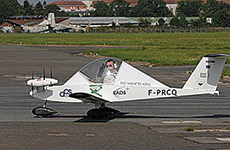 Although its small size always makes it endearing, the CriCri’s latest mission takes advantage of the airplane’s diminutive mass as a testbed for green propulsion technology. A CriCri powered by four electric engines first flew at Paris’ Le Bourget Airport during the Green Aviation Show held June 18 through 22, 2010. This particular project was funded by a European Aeronautic Defense and Space Company (EADS) unit called EADS Innovation Works (IW), Aero Composites Saintonge, and the Green CriCri Association.
Although its small size always makes it endearing, the CriCri’s latest mission takes advantage of the airplane’s diminutive mass as a testbed for green propulsion technology. A CriCri powered by four electric engines first flew at Paris’ Le Bourget Airport during the Green Aviation Show held June 18 through 22, 2010. This particular project was funded by a European Aeronautic Defense and Space Company (EADS) unit called EADS Innovation Works (IW), Aero Composites Saintonge, and the Green CriCri Association.
The engines are mounted in a push-pull configuration, á la the Cessna Skymaster, with two engines mounted per side in a tandem configuration. Power for the engines comes from lithium ion batteries. So far, the principals are calling the electric CriCri a technology demonstrator, but it’s caught the European public’s attention—as only a CriCri can do.
The airplane’s first flight lasted seven minutes, and pilot Didier Esteyne reported no vibrations, excellent maneuverability, and no squawks. “This aircraft flies very smoothly, much more quietly than an airplane with conventional propulsion,” he said. “But we are still at the beginning and have a lot to learn. We are allowed to start aerobatic maneuvers only after five hours of flight and 15 landings. By now, those milestones must surely have been met.”
The goal was to develop this CriCri so as to provide 30 minutes of cruise flight at 60 knots, or 15 minutes of aerobatic flying at speeds up to 135 knots. Target rates of climb are set in the 1,000-fpm range.
Although EADS—an aerospace giant—says that the electric CriCri is meant to help in studying hybrid propulsion concepts for helicopters, you can’t help but wonder what’s next. A solar-powered CriCri?
—Thomas A. Horne
Video and photography by Chris Rose
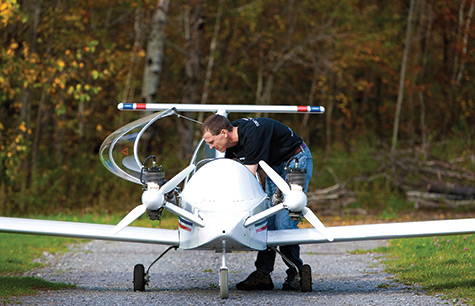
It has a 16-foot wingspan; weighs just 185 pounds; has a pair of two-stroke, 15-horsepower engines; climbs at 1,000 fpm; and has a roll rate of 200 degrees per second. This tiny aviation curiosity is the CriCri.
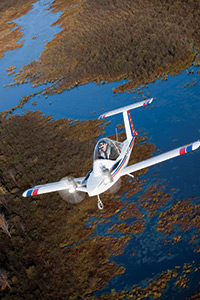 Designed in the late 1960s by French aeronautical engineer Michel Columban, it first flew on July 19, 1973, and jaws have been dropping ever since anywhere a CriCri makes an appearance. Ours dropped when we first saw the CriCri in a 1974 issue of Air Progress magazine. Right then and there, we knew we had to have one. After not owning an aircraft for nearly a decade, we were looking for an aircraft that was aerobatic, fun to fly, and technically interesting. The CriCri would be ideal as our next aircraft, so we began our hunt.
Designed in the late 1960s by French aeronautical engineer Michel Columban, it first flew on July 19, 1973, and jaws have been dropping ever since anywhere a CriCri makes an appearance. Ours dropped when we first saw the CriCri in a 1974 issue of Air Progress magazine. Right then and there, we knew we had to have one. After not owning an aircraft for nearly a decade, we were looking for an aircraft that was aerobatic, fun to fly, and technically interesting. The CriCri would be ideal as our next aircraft, so we began our hunt.
Columban gave the airplane one of his daughter’s nicknames, and his children can often be seen in photographs of the prototype CriCri under construction—giving the distinct impression that both the children and the little airplane benefited from a doting father. The name “Cricket” was later adopted as an English translation of the original “CriCri.”
Structure
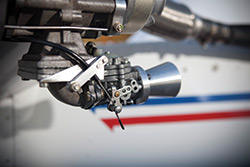 The CriCri is a homebuilt you must build from plans. Its primary structure is a mix of aluminum and Klegecell, a type of dense foam, and assembly is a mix of Avex pop rivets and epoxy.
The CriCri is a homebuilt you must build from plans. Its primary structure is a mix of aluminum and Klegecell, a type of dense foam, and assembly is a mix of Avex pop rivets and epoxy.
The wings and horizontal stabilizer are made of an aluminum spar, Klegecell ribs, and one-piece aluminum skins that cover the ribs and are riveted along the trailing edge. The fuselage is a simple square structure, built of aluminum, with some Klegecell added to the aluminum stringers for reinforcement. The wings fasten like a sailplane’s, allowing for assembly and disassembly in minutes, so the airplane fits neatly on a trailer. The entire structure is glued together with epoxy during final assembly.
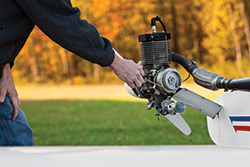 Power is provided by two single-cylinder French JPX 212-cc engines that develop about 15 horsepower each—thanks to tuned exhaust pipes and very high prop speeds—6,500 rpm. Starting is achieved by either pulling a rope at the rear of the engine or by giving the little 27-inch propellers a swift turn.
Power is provided by two single-cylinder French JPX 212-cc engines that develop about 15 horsepower each—thanks to tuned exhaust pipes and very high prop speeds—6,500 rpm. Starting is achieved by either pulling a rope at the rear of the engine or by giving the little 27-inch propellers a swift turn.
Testing C-FPTJ
Early in 2009 we found our CriCri, C-FPTJ. It’s a beautifully built MC 15 CriCri (the “MC” stands for Michel Columban). That’s the good news. The not-so-good news was that this CriCri had only flown four times since being built. Not wanting to fall into the trap that snares so many overeager pilots on the first flights of their experimental aircraft, we needed a competent test pilot to make sure that the airplane was safe to fly throughout its very wide flight envelope. Luckily, Ronald is an experienced test pilot who had just completed a stint test-flying an experimental Boeing 707. Who better to test-fly what the Guinness Book of World Records calls the world’s smallest twin-engine aircraft?
 After a thorough inspection, engine runs, and engine tuning, the time came to fly in June 2009. Our approach from the onset was very professional—that is, cautious, incremental, and always trying to anticipate the unexpected. It wouldn’t be long in coming.
After a thorough inspection, engine runs, and engine tuning, the time came to fly in June 2009. Our approach from the onset was very professional—that is, cautious, incremental, and always trying to anticipate the unexpected. It wouldn’t be long in coming.
Testing started with both of us flying down the length of a runway, just a few feet in the air. Performance and stability clearly were not an issue; controls were responsive, well harmonized, and felt like those of an aerobatic aircraft. The lack of forward fuselage references made it difficult to judge the landing flare—and avoid tail strikes—which was resolved by adding canopy reference marks.
Later the same day we made our first flights to altitude. During Ronald’s first climbout the right engine began running very rough, so he partially retarded the throttle. That’s when we discovered that the CriCri would indeed climb on a single engine; the trip back to the runway was a nonevent. Re-tuning the offending engine solved the problem, but we also overhauled both carburetors after this incident.
Then came some flights involving a few gentle stalls, then more flights to expand the flight envelope and make sure there were no aileron or elevator flutter issues.
Faster and faster
During runs at ever-increasing airspeeds, the controls were repeatedly tapped sharply and then released for a few seconds to see if flutter occurred. When full-throttle airspeed was reached, the airspeed was further increased by diving at increasingly steeper angles until airspeeds up to VNE had been confirmed free of flutter.
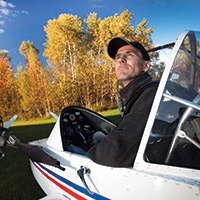 The next step in the envelope expansion was testing the structural integrity of the airframe. Sustained turns at ever-increasing bank angle were used to apply increasing G loading, and airspeed was constantly increased to remain above the accelerated stall. Once again, when full throttle was reached, the airspeed was further increased by diving during the turn.
The next step in the envelope expansion was testing the structural integrity of the airframe. Sustained turns at ever-increasing bank angle were used to apply increasing G loading, and airspeed was constantly increased to remain above the accelerated stall. Once again, when full throttle was reached, the airspeed was further increased by diving during the turn.
The final steps of the envelope expansion involved aerobatic and departed flight. That’s when we confirmed that the stalls are gentle and symmetrical, and have no tendency to drop a wing. As other CriCri pilots have reported, the aircraft rolls beautifully and effortlessly and happily flies about inverted. The full-span ailerons are light, and the aircraft does a complete roll in less than two seconds. Inverted flight is very comfortable, with no worries about the loss of engine oil pressure (a constant concern in piston-powered aerobatic aircraft), given that the fuel and oil are mixed together.
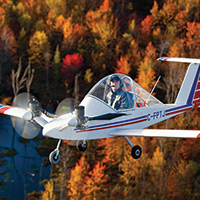 We investigated more stalls and spins—including aggravated spins—before investigating additional aerobatic maneuvers (the aerobatic CriCri is stressed for 4.5 positive Gs). That’s because failed aerobatic maneuvers can result in unintentional spins. Because Ronald is an expert on flat and accelerated spins, he stepped up to the plate for the spin trials, which were satisfactory. Then came engine-out work—easy to handle, because VMC (minimum control airspeed with the critical engine inoperative) is lower than the stall speed, and the propellers don’t feather.
We investigated more stalls and spins—including aggravated spins—before investigating additional aerobatic maneuvers (the aerobatic CriCri is stressed for 4.5 positive Gs). That’s because failed aerobatic maneuvers can result in unintentional spins. Because Ronald is an expert on flat and accelerated spins, he stepped up to the plate for the spin trials, which were satisfactory. Then came engine-out work—easy to handle, because VMC (minimum control airspeed with the critical engine inoperative) is lower than the stall speed, and the propellers don’t feather.
Even so, the CriCri has a positive rate of climb on one engine. But that rate is variable and depends on air temperature; density altitude; aircraft and pilot weight; and whether the engines and wheels are equipped with fairings. While single-engine rates of climb are not advertised, the recommended single-engine climb speed is 75 mph, and the flaps should be retracted.
A typical flight
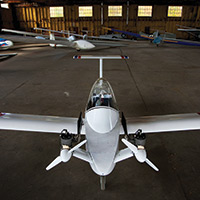 A typical flight starts with a complete inspection. Key items to verify are the security of the six spar pins (three pins per wing) and two glider-type flaperon quick-connect fittings. Up to six gallons of fuel is added to the fuel tank under the pilot’s legs, and then the engines are primed by covering the carburetor intake and turning the propeller through five blades. Then you wrap a starting rope around the flywheel on the back of each engine and give a yank. They typically start on the first attempt.
A typical flight starts with a complete inspection. Key items to verify are the security of the six spar pins (three pins per wing) and two glider-type flaperon quick-connect fittings. Up to six gallons of fuel is added to the fuel tank under the pilot’s legs, and then the engines are primed by covering the carburetor intake and turning the propeller through five blades. Then you wrap a starting rope around the flywheel on the back of each engine and give a yank. They typically start on the first attempt.
There is little to do during the pretakeoff check, apart from checking for full static rpm (5,200 rpm) and setting the Junkers-style flaperons to the takeoff position (12 degrees). There are no mixture controls, no cowl flaps, no carb heat, no oil pressure to verify on the two-stroke JPX engines. Then it’s time to taxi. The nosewheel steering is great, and a single lever operates drum brakes on both main wheels.
 But fun begins on the takeoff run. Acceleration is quick, and soon you’re off the ground at about 50 mph and climbing away at 75 mph and 1,000-plus fpm, with the engines dialed back to the takeoff setting of 5,500 rpm. What’s staggering is the visibility. It’s like you’re sitting in the middle of an aquarium! And talk about an airplane you wear—the wing tips are barely seven feet beyond the canopy, and those two little engines make an oscillating hum when their props need to be synchronized. Ordinarily, though, their tuned exhausts make for a smooth, if somewhat loud, ride.
But fun begins on the takeoff run. Acceleration is quick, and soon you’re off the ground at about 50 mph and climbing away at 75 mph and 1,000-plus fpm, with the engines dialed back to the takeoff setting of 5,500 rpm. What’s staggering is the visibility. It’s like you’re sitting in the middle of an aquarium! And talk about an airplane you wear—the wing tips are barely seven feet beyond the canopy, and those two little engines make an oscillating hum when their props need to be synchronized. Ordinarily, though, their tuned exhausts make for a smooth, if somewhat loud, ride.
Going somewhere? I’ve found that cruise speeds around 120 mph are realistic. At cruise power, count on a fuel burn of 1.25 gph per side, or 2.5 gph total. This gives you a range of around 250 nm.
Aerobatics
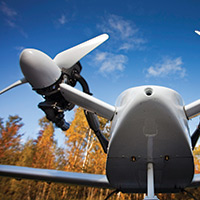 The first time we rolled the CriCri, we found it absolutely delightful. It didn’t roll as quickly as our Pitts or Yak, but it rolls very quickly, and the ailerons are very crisp.
The first time we rolled the CriCri, we found it absolutely delightful. It didn’t roll as quickly as our Pitts or Yak, but it rolls very quickly, and the ailerons are very crisp.
One of the CriCri’s unique aerobatic capabilities is its aptitude at performing cartwheels—which are one-and-a-half-turn wing-overs. As the yaw turn is performed at the top of the vertical line, the inboard engine is brought to idle while the outboard is left at full power.
Around the patch
For landing, the CriCri’s flaps are normally lowered two notches (27 degrees) to their landing position on the downwind leg. The flaps have two functions: to lower the stall speed, and increase drag on this very clean little airplane.
 The pattern and approach are flown at about 65 to 70 mph, well above the flaps-down stall speed of 45 mph. The airplane is quite stable when landing in strong, gusty winds. This often comes as a surprise to onlookers who assume that the aircraft will not be able to handle anything but calm weather conditions. The stability is because of the CriCri’s higher wing loading.
The pattern and approach are flown at about 65 to 70 mph, well above the flaps-down stall speed of 45 mph. The airplane is quite stable when landing in strong, gusty winds. This often comes as a surprise to onlookers who assume that the aircraft will not be able to handle anything but calm weather conditions. The stability is because of the CriCri’s higher wing loading.
One item that causes some difficulty to new CriCri pilots is the lack of forward reference during the landing flare. The only forward references for judging the flare are the two engine cylinders, so you need to keep their proper attitudes in mind when rounding out. Here’s another nice-to-know item for those new to the CriCri: A too-aggressive flare can sometimes result in a tail-skid strike. Easy definitely does it with the CriCri’s super-sensitive controls. What you’re aiming for is a nice, nose-high—but not too nose-high—touchdown at approximately 50 mph.
SPECS IN BRIEF
- Wing span 16 ft
- Length 12 ft 10 in
- Empty weight 185 lb
- Max. takeoff weight 420 lb
- V NE 160 mph
- Max level speed 135 mph
- Stall (flaps down) 45 mph
- Rate of climb 1,000+ fpm
- Range ~250 statute miles
- Operating load +4.5G / -2.25G
(These figures are half of the breaking load)
A showstopper
Another great thing about owning a CriCri is simply showing up at any airport. When people see the CriCri for the first time, they usually stand there with their mouths open, not knowing quite what to say. Its remarkably small size and superb engineering attracts the attention of all pilots. Engineers and homebuilders are keen to talk about the engines, handling characteristics, and construction technique—and everybody asks if it will fly on one engine.
 The CriCri looks very much like something the 1960s cartoon character George Jetson would fly. And it’s a timeless design. Its first major U.S. debut was at the Experimental Aircraft Association’s 1981 annual event in Oshkosh, Wisconsin. There, two CriCris astounded onlookers with their capabilities, including unforgettable sessions of formation aerobatics. One of those two French pilots—this one now an Airbus A380 captain—returned to Oshkosh in 2009. And he brought his CriCri with him—aboard his A380! For grins, he displayed his CriCri beside the main gear of the Airbus, and it drew as many gawkers as the giant airliner towering above.
The CriCri looks very much like something the 1960s cartoon character George Jetson would fly. And it’s a timeless design. Its first major U.S. debut was at the Experimental Aircraft Association’s 1981 annual event in Oshkosh, Wisconsin. There, two CriCris astounded onlookers with their capabilities, including unforgettable sessions of formation aerobatics. One of those two French pilots—this one now an Airbus A380 captain—returned to Oshkosh in 2009. And he brought his CriCri with him—aboard his A380! For grins, he displayed his CriCri beside the main gear of the Airbus, and it drew as many gawkers as the giant airliner towering above.
David Smith is a project manager for Bombardier’s business aircraft division in Montreal, Canada. A commercial pilot with 2,000 flight hours, he’s also rated in gliders. His brother, Ronald Smith is an ATP with 12,000 hours who recently flew a Boeing 707 engine testbed for Pratt & Whitney. He is restoring a 1946 Bellanca CruiseAir and a One Design aerobatic aircraft. Over the years, they have shared ownership of a Yak 55M, Steen Skybolt, Pitts Special, and de Havilland Chipmunk.


